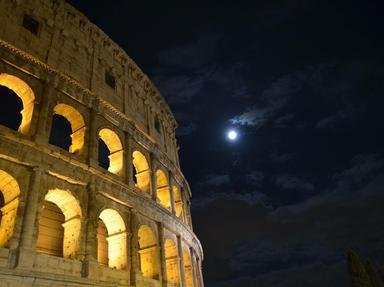Quiz Answer Key and Fun Facts
1. This Roman was thought to be quite mad. To prove to the Romans that he was capable of a victory, he tried to invade England. When bad weather meant he couldn't even cross the Channel, he apparently chose some of his own men, pretended they were captured Englishmen, and paraded them back to Rome. Which emperor was this?
2. The Emperor Vespasian isn't one you hear about very much. However, he was responsible for an oval structure that still stands today in Rome. Construction, which took nearly a decade, was finished in 80 AD. What is this famous structure that was built over Nero's lake?
3. The famous Pantheon in Rome still stands today. Originally built in 27 BC, it was destroyed by fire in 80 AD and then by a bolt of lightning in 110 AD. Which emperor, who was more famous for a wall, was responsible for rebuilding it?
4. This music-loving emperor had a mother who reportedly poisoned numerous adversaries. The mother was ambitious, power-hungry and ruthless. The son was debauched and insanely cruel. A recipe for matricide, who was the emperor who organised the murder of his own mother?
5. Titus was the emperor of Rome for just two short years. During his reign he had to deal with not one, but two major catastrophic events. One was a massive fire that raged through Rome for three days and nights in 80 AD. What was the other?
6. Which emperor, who was the adopted son of Julius Caesar and the first Emperor to rule Ancient Rome, was responsible for winning the Battle of Actium against Mark Antony and Queen Cleopatra's forces?
7. This Roman emperor was the first to actually conquer parts of Britain. Known for having disabilities such as a stutter, a limp and slight deafness - and for dying after eating a plate of mushrooms - who was this man?
8. Which Roman ruler converted to Christianity, promoted religious tolerance through the 'Edict of Milan', and set up a base for the Roman empire in a city in the east?
9. This emperor was cruel from a young age. Obsessed with sports and with a voracious sexual appetite, he was the only emperor who fought in the Colosseum, killing animals and fighting gladiators. Who was this despot who was eventually murdered?
10. Most of us know what happened to Julius Caesar. However before his rather savage demise, Julius Caesar was responsible for some very strategic military feats. While he was laying siege to his enemy, the Gauls, in Alesia in 52 BC - he received word that a relief army was coming to aid the Gauls. How did Julius Caesar respond?
Source: Author
heatherlois
This quiz was reviewed by FunTrivia editor
ponycargirl before going online.
Any errors found in FunTrivia content are routinely corrected through our feedback system.
